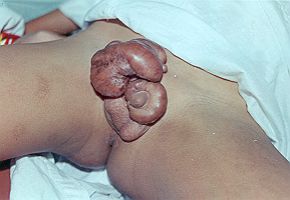
Annals of Burns and Fire Disasters, Volume XII, Issue 3, September 1999.
Faculty of Medicine for Girls, Azhar University, Cairo, Egypt
Circumcision, performed for religious reasons at or after birth, is a relatively simple operation to perform with relatively few complications. However, any complication arising from this operation should be viewed with dismay. A very rare complication is a post-circumcision keloid, observed in 1994 in a boy from Aswan, Egypt. Circumcised one year before presenting, the boy had a huge mass obscuring the entire penis except the glans penis, extending proximally to the suprapubic region. Excision of the mass and histopathological studies proved it was a keloid. Reconstruction of the penis and suprapubic region was achieved with satisfactory results.
It has been estimated that about one-sixth of the world's population practises circumcision for religious reasons. 1-2 The practice goes back to as early as 3200 BC in Egypt and it may derive from the practice of mutilating prisoners-of-war retained to work as slaves.' This may have developed into ritual circumcision, which is imbued with great moral significance and carried out in Jewish and Moslem communities.
An economically disadvantaged, light-brown six-year-old boy from Aswan, upper Egypt, had undergone a routine circumcision for cultural reasons. The operation was performed by an inexpert surgeon who removed excessive penile skin, causing long-standing infection. After healing the scar started to elevate. It became hypertrophic and more prominent and grew continuously until it spread beyond the wound and involved the dorsal penile skin as far as the suprapubic region, forming a huge mass (Figs. 1, 2).
The patient presented at the Azhar University Hospital in 1996 with this huge mass. The history and the clinical examination suggested a keloid. The normal measures for keloid treatment such as pressure bandage, injection of triameinolone, superficial irradiation or the use of silicone gel or sheet, were not indicated. Complete excisional biopsy was planned in view of the high rate of recidivation. Reconstruction of the suprapubic region and penile shaft, covered by a thin split-thickness skin graft, was performed. The histopathological study confirmed the presence of a keloid. The wound healed perfectly when a silicone sheet and gel were used regularly for three months at the sites of the scars and on the dorsum of the penis. The followup lasted about six months, during which time there was a small elevated suprapubic scar only but without itching, redness or any sign of keloid recurrence (Figs. 3, 4).
Circumcision is prevalent and the complication rate, whether immediate or late, ranges from 0-2% to 5 %. Keloid after circumcision has not previously been described, and this is the only case I have observed. It is exceedingly rare in the genitalia. According to Brown, the skin of the penis never forms a keloid
, while Crockett did not find any cases of keloid formation in a review of 250 native Sudanese patients! One case only of true keloid of the penis following circumcision was reported in 1993, in a coloured boy aged ten years old from Sierra Leone, with regard to whom it is said: we report what we believe is the first documented case of keloid formation of the penis following circumcision.
The case considered here is the second recorded of a true post-circumcision keloid with massive and extended lesions. With regard to the treatment and management of this type of keloid it is very difficult to proceed with such recognized methods as local pressure, irradiation or injection of local steroids. The only line of treatment possible was surgical excision, taking cafe to prevent a recurrence of the initial causes of the infection. The normal wound healing processes could be used with the assistance of a slightly adhesive silicone gel to prevent recurrence of the keloid.
Keloids are not often observed in the penis. This abnormal site needs special treatment, in which local pressure is unsuitable, irradiation is dangerous to the testes, and the local injection of triamcinolone is very painful and difficult in children. However, the use of a silicone gel sheet is very effective and suitable for the function of the penis.
La circoncision, pratiquée à ou pou après la naissance pour des raisons religieuses, est une opération relativement simple qui non-nalement ne présente pas de complications. Mais il faut dire que toutes les complications causées par cette opération doivent M-jtre considerées avec consternation. Une complication très rare est representée par le chéloM-ode post-circoncisionnel, observé dans un jeune mM-ble à Assouan (Egypte). Le patient, opéré un an avant d'être porté à l'Auteur, présentait une énorme masse qui couvrait tout le glans penis et s'étendait proximalement jusqu'à le région subrapubique. L'excision et l'analyse histologique de la masse ont démontré sa nature chéldide. La reconstruction du pénis et de la région suprapubique a été effectuée avec des résultats satisfaisants.
Histoire de la Circoncision, des Origines à nos Jours. Bolland (ed.), Paris, 1992.
Kinderurologie in Klinik und Praxis, Stuttgart, New York, 1986.<
This paper was received on 5 November 1998.
Address correspondence to:
Dr Usama Saad Eldin
Faculty of Medicine for Girls
Azhar University
Cairo, Egypt.
The Circumcision Information and Resource Pages are a not-for-profit educational resource and library. IntactiWiki hosts this website but is not responsible for the content of this site. CIRP makes documents available without charge, for informational purposes only. The contents of this site are not intended to replace the professional medical or legal advice of a licensed practitioner.
© CIRP.org 1996-2024 | Filetree | Please visit our sponsor and host:
IntactiWiki.